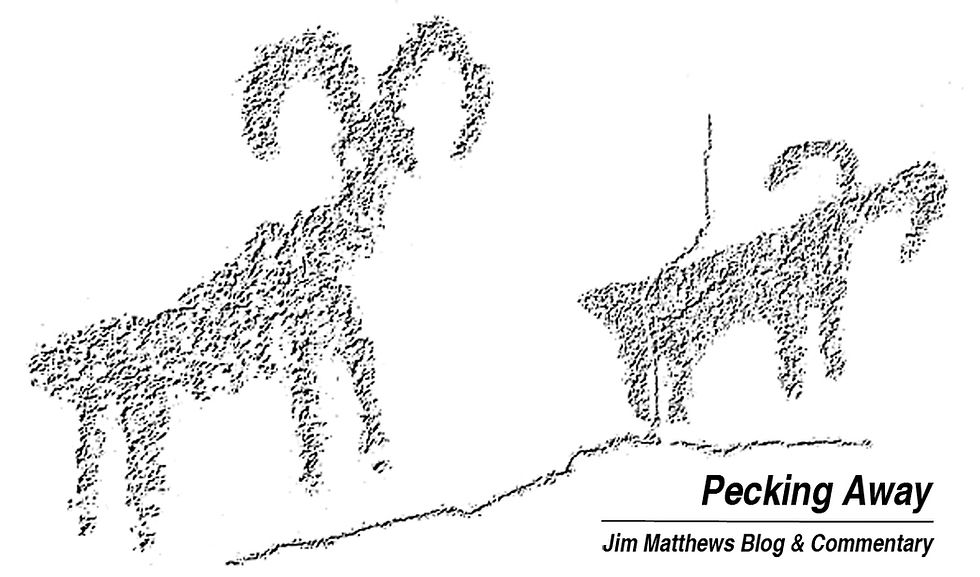A solution to a problem he created: Obama designates 1.8 million acres as new national monuments in
- Jim Matthews
- Feb 14, 2016
- 4 min read

By JIM MATTHEWS
www.OutdoorNewsService.com
President Obama created three new national monuments in the Mojave Desert on Feb. 11 this month, by wielding his pen through the Antiquities Act, and ending years of legislative wrangling.
The designation gives 1.8 million acres of existing federal lands new names and wraps them in new boundaries, but it will probably do little else.
With one glaring exception: The designation will stop all new solar and wind energy developments and preclude any new mining.
It is only a little ironic that it was Obama’s own policies on “clean” energy that led to a rush from major green energy developers to lease and build solar and wind farms all over the Southern California desert, environmental consequences scuttled for the greater good of the environment.
No, that last sentence doesn’t make sense. It never has. But that is what the Obama Administration and many environmentalists promoted early in Obama’s term -- at least environmentalists not from here. They wanted to cover the desert with industrial-scale solar and wind projects for a green world. No one apparently told them these large “green” projects are environmental disasters in our deserts, and their negative impacts have proven to outweigh any pluses that accrue on the “green” energy side of the equation.
So now we have a pre-emptive strike to create monuments to protect pristine desert from energy developments. This is a solution to a problem that was created by the same people who have now solved part of the problem they created.
But we really have no idea what other impacts and problems the creation of these new national monuments will create.
It is hoped the monument designation will bring additional funding for the management of these lands. That increase in funding hasn’t happened with the Carrizo National Monument or the more recent San Gabriel National Monument. The Bureau of Land Management (which manages the Carrizo) and the U.S. Forest Service (which manages the San Gabriel) found increased duties with the new designation -- but without additional funding to do the job. As a consequence, public lands and resources in Carrizo Plain and San Gabriel Mountains have actually suffered from the new designation and bloating of the bureaucracy.
Without defined parameters (like those that would be spelled out with legislation as opposed to presidential fiat), public users and private land owners within the new monuments have no idea how management will change. Will long-used, off-road recreation areas be closed? Will hunting be curtailed? Will vast areas simply be closed to all public access because there isn’t the funding to maintain access? Will a land-owner be allowed to have a couple of cows or build a barn on his own land? Will he be forced to sell out to the government?
Who knows? With other presidential monument designations in California, almost nothing has changed for the public -- which is a good thing. The public can still hike and backpack the same trails, hunt the same canyons, ride their quads on the same rutted routes (well, maybe not ALL the same rutted routes), and even build a cabin on their own property.
But the designation puts all these activities in a new box, ripe for new rules and greater government control.
What could go wrong?
The best-case scenario is that nothing you like doing in the desert will be impacted and the politicians all get to slap themselves on the back and brag about their environmental legacy and how they protected the desert from big energy companies. (Never mind the part where they encouraged the big energy companies in the first place.)
In a worse-case scenario, your worst nightmares will come true.
Summary of Monument Designations:
--Mojave Trails National Monument: This 1.6-plus million acre monument is made up of federal and historic railroad lands in a 100-plus mile swath on both sides of historic Route 66 in the east Mojave Desert between the Mojave National Preserve and Joshua Tree National Park.
-- Sand to Snow National Monument: This 154,000-acre monument is made up of federal land between Joshua Tree National Park and the San Bernardino National Forest, including a 24-mile stretch of the Pacific Crest Trail.
-- Castle Mountains National Monument: The smallest of the three designation, this monument encompasses 20,920 acres on the east side of the Mojave National Preserve and on the Nevada border.
END
Lake Elsinore restocked with catfish;
bass, bluegill, and crappie plants next
Hammered by historic drought, the fishery at Lake Elsinore has declined dramatically over the past three years. City officials decided that an El Niño winter was the perfect time to jump-start the lake’s recovery.
Over 1,600 pounds of catfish -- most mature fish that will spawn this spring -- were planted this past Friday (Feb. 12). Those fish will be joined by 400 adult largemouth bass, 2,000 bluegill, and 3,000 black crappie, all scheduled to be planted this coming Wednesday (Feb. 17).
END
[Jim Matthews is a syndicated Southern California-based outdoor reporter and columnist. He can be reached via e-mail at odwriter@verizon.net or by phone at 909-887-3444.]























Comments